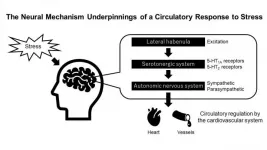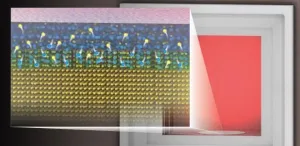INFORMATION:
Salt substitution -- an effective way to reduce blood pressure in rural India
2021-03-30
(Press-News.org) Replacing regular common salt consumed by hypertensive patients in rural areas with a salt substitute can have a significant impact in terms of lowering their blood pressure, a new study by The George Institute for Global Health has revealed.
Researchers found that substituting a small part of the sodium in salt with potassium without altering the taste led to a substantial reduction in systolic blood pressure in these patients, supporting salt substitution as an effective, low-cost intervention for lowering blood pressure in rural India.
The study entitled "Effects of reduced-sodium added-potassium salt substitute on blood pressure in rural Indian hypertensive patients: a randomized, double-blind, controlled trial" provides the first-of-its-kind evidence from rural India on the effectiveness of a salt substitute and has been published in the American Journal of Clinical Nutrition.
Excess salt intake causes high blood pressure, a leading risk for cardiovascular disease. Almost all adult populations worldwide consume more than the recommended level of salt including those living in rural India, where average salt intake is nearly double the World Health Organization (WHO) recommendations of less than 5 g/day (2 g/day sodium).
"A large proportion of dietary salt in India comes from salt added to food cooked at home, but whether reduced-sodium salt substitutes can help to lower blood pressure had not been tested thus far," said Dr Jie Yu, Research Fellow, Cardiovascular Program, The George Institute and lead author of the study. "Our study is the first to show that salt substitutes could make a real difference in these communities."
"The study was conducted in the Siddipet region of Telangana State, and 502 participants with hypertension from 7 villages were enrolled," She added, "Participants were randomized to receive either regular salt (100% sodium chloride) or the salt substitute (70% sodium chloride/30% potassium chloride blend) and advised to replace all home salt use with the substitute."
The primary outcome was the change in systolic blood pressure from baseline to 3 months in the salt substitute group compared to the regular salt groups. Secondary outcomes included the change in diastolic blood pressure, 24-hour urinary biomarkers, and self-reported use and satisfaction with the study salts provided.
"At 3 months, the salt substitute intervention significantly decreased average systolic blood pressure by about 4.6 units, an effect comparable to some commonly prescribed anti-hypertensive medications," said Sudhir Raj Thout, Research Fellow, The George Institute India, the study co-author who led the study's field operations.
"There was also a significant increase in the amount of potassium consumed in the salt substitute group. Participants reported that they used the study salt nearly every day of the week and rated the taste of the study salts similarly, indicating that the reduced-sodium salt substitutes are acceptable for home cooking for our study participants." he added.
The findings have policy implications. "Our data suggest that using reduced-sodium, added-potassium salt substitute to replace regular salt for home cooking will likely be an effective and scalable intervention for blood pressure control in rural India," said Jason Wu, Associate Professor and Scientia Fellow at The George Institute, and supervisor of the study.
"As none of the participants were aware of the existence of reduced-sodium salt at the beginning of the study, this suggests policymakers should consider supporting increased access to, and education about the use of such salt substitutes for hypertensive patients in India."
ELSE PRESS RELEASES FROM THIS DATE:
The third generation of siRNA delivery system makes RNAi therapy feasible
2021-03-30
In a new study published in the Cell Research, Chen-Yu Zhang's group at Nanjing University reports "In vivo self-assembled small RNA is the new generation of RNAi therapeutics".
The development of RNAi therapy has undergone two major stages, direct injection of synthetic siRNAs and delivery with artificial vehicles; both have not realized the full therapeutic potential of RNAi in clinic. In this study, Chen-Yu Zhang's group reprogram host liver with genetic circuits to direct the synthesis and self-assembly of siRNAs into secretory exosomes. In vivo assembled siRNAs are systematically distributed to multiple tissues or targeted to specific tissues (e.g., brain), inducing potent target gene silencing in these tissues. The therapeutic value of this strategy is demonstrated ...
Algorithm-based music recommendations: Low accuracy for lovers of non-mainstream music
2021-03-30
A team of researchers from Graz University of Technology, Know-Center GmbH, Johannes Kepler University Linz, University of Innsbruck, Austria and University of Utrecht, the Netherlands, compared how accurate algorithm-generated music recommendations were for mainstream and non-mainstream music listeners. They used a dataset containing the listening histories of 4,148 users of the music streaming platform Last.fm who either listened to mostly non-mainstream music or mostly mainstream music (2,074 users in each group). Based on the artists music users' listened to most frequently, the authors used a computational model to predict how likely music users were to like the music recommended ...
Urban and transport planning linked to 2,000 premature deaths per year in Barcelona and Madrid
2021-03-30
Failure to comply with international exposure recommendations for air pollution, noise, heat and access to green space is associated with more than 1,000 deaths per year in Barcelona and more than 900 in Madrid, accounting for 7% and 3% of overall premature mortality, respectively.
This is the conclusion of a new study by the Barcelona Institute for Global Health (ISGlobal), a centre supported by the "la Caixa" Foundation. This study is the first to estimate premature mortality impacts and the distribution by socioeconomic status of multiple environmental exposures related to urban planning and transport in the two cities.
Today, more than half of the ...
The neural mechanism of a circulatory response to stress
2021-03-30
Tsukuba, Japan - Although the heart beats autonomously, its function can be regulated by the brain in response to, for instance, stressful events. In a new study, researchers from the University of Tsukuba discovered a novel mechanism by which a specific part of the brain, the lateral habenula (LHb), regulates the cardiovascular system.
The cardiovascular system, specifically the heart and blood vessels, have a certain autonomy that allows them to function independently from the brain. In order for the individual to adapt to new, potentially threatening situations, the brain does have some regulatory power over the cardiovascular ...
Chronic inflammatory liver disease: cell stress mechanisms identified
2021-03-30
Primary sclerosing cholangitis (PSC) is a rare, chronic, inflammatory disease of the bile ducts and is difficult to treat, since its causes have not yet been adequately researched. Using RNA sequencing, an international research consortium led by Michael Trauner, Head of MedUni Vienna's Division of Gastroenterology and Hepatology (Department of Medicine III), has now succeeded in identifying a new prognostic factor for PSC from liver biopsies. This is so-called cellular ER stress. ER stress is the name given to a complex cellular response to stress caused by the build-up of misfolded proteins in the endoplasmic reticulum (ER).
PSC is a rare disease with a poor prognosis and can lead to cirrhosis ...
New AI-based versatile software for tracking many cells in 3D microscope videos
2021-03-30
In modern basic life science research as well as in drug discovery, recording and analyzing the images of cells over time using 3D microscopy has become extremely important. Once the images have been recorded, the same cell in different images at different time points has to be accurately identified ("cell tracking") because the living cells captured in the images are in motion. However, tracking many cells automatically in 3D microscope videos has been considerably difficult.
In the Kimura laboratory at the Nagoya City University, Dr. Chentao Wen and colleagues developed the 1st AI-based software called 3DeeCellTracker that can run on a desktop PC and automatically track cells in 3D microscope videos. ...
Researchers reveal SARS-CoV-2 distribution and relation to tissue damage in patients
2021-03-30
Researchers have mapped the distribution of SARS-CoV-2, the virus that causes COVID-19, in deceased patients with the disease, and shed new light on how viral load relates to tissue damage.
Their study of 11 autopsy cases, published today in eLife, may contribute to our understanding of how COVID-19 develops in the body following infection.
More than 24 million SARS-CoV-2 infections have been reported to date, and the number of deaths attributed to COVID-19 has exceeded 828,000 worldwide. COVID-19 occurs with varying degrees of severity. While most patients have mild symptoms, some experience more severe symptoms and may need to be hospitalised. A minority of those in hospital may enter a critical condition, with respiratory failure, blood vessel complications, or multiple organ ...
Cardiorespiratory fitness improves grades at school
2021-03-30
Recent studies indicate a link between children's cardiorespiratory fitness and their school performance: the more athletic they are, the better their marks in the main subjects - French and mathematics. Similarly, cardiorespiratory fitness is known to benefit cognitive abilities, such as memory and attention. But what is the real influence of such fitness on school results? To answer this question, researchers at the University of Geneva (UNIGE), Switzerland tested pupils from eight Geneva schools. Their results, published in the journal Medicine & Science in Sport & Exercise, show that there is an indirect link with cardiorespiratory fitness influencing ...
Breaking records like baking bread
2021-03-30
Alloying, the process of mixing metals in different ratios, has been a known method for creating materials with enhanced properties for thousands of years, ever since copper and tin were combined to form the much harder bronze. Despite its age, this technology remains at the heart of modern electronics and optics industries. Semiconducting alloys, for instance, can be engineered to optimize a device's electrical, mechanical and optical properties.
Alloys of oxygen with group III elements, such as aluminum, gallium, and indium, are important semiconductor materials with vast applications ...
Beetle outbreak impacts vary across Colorado forests
2021-03-30
It's no secret. Colorado's forests have had a tough time in recent years. While natural disturbances such as insect outbreaks and wildfires occurred historically and maintained forest health over time, multiple, simultaneous insect disturbances in the greater region over the past two decades have led to rapid changes in the state's forests.
A bird's eye view can reveal much about these changes. Annual aerial surveys conducted by the Colorado State Forest Service and USDA Forest Service have provided yearly snapshots for the state. New collaborative research led by Colorado State University and the University of Wisconsin-Madison now supplements this understanding with even greater spatial detail.
The ...



